
Today, more than any other so far, would be Temple day. There are
many, many temples and palaces and things to see in
Kyoto, and I had one full day to see as many of them as possible. At one point. Kyoto was the imperial capital of Japan, but it lost that title to Tokyo (though there is no legal definition of this).
Tokyo grew into the modern metropolis it is today, whereas Kyoto, whilst still embracing new culture and technology, stuck more to its traditional roots and today has much more of an authentic air about it.
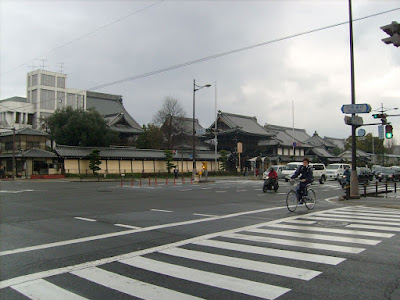
Unfortunately, things were not looking too good. My energy levels had taken a battering as the first night in the swanky Apa Hotel had been a bit rough. I had spent most of the night awake, my stomach feeling more off than before, and there seemed to be something about the room that wasn't quite
right, like it was on top of a huge electromagnet or something, a strange low-level buzzing kept me from a peaceful snooze.
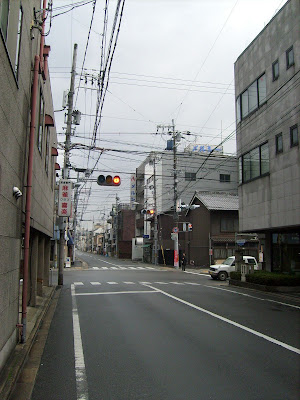
Whatever it was, that night was a hot and restless one, and by early morning it was pretty clear that I wasn't going to get any more sleep. Still groggy, I decided to leave at 7.30 am after tracing a route around central Kyoto that would take in as many of the main shrines as possible. In one day, there was no chance whatsoever of getting all of them, but I'd give it my best shot.
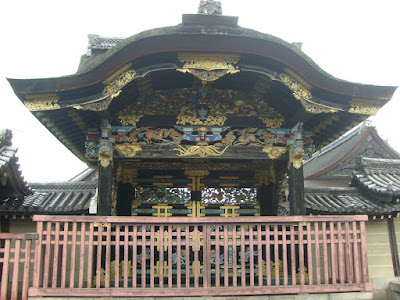
At that time in the morning, there tends to be not so many things open so eschewing a bite to eat (as I really didn't feel capable) I started out down the back streets towards the first temple, splashing through the dampened streets that had clearly seen their share of showers overnight, I shared the narrow streets with the cars. Compared to the lush,
modern facade that had greeted my entrance to the former capital, it only took a couple of hundred yards for that to be replaced by much more mundane, inner city sprawl.
Nishi-Hognan-Ji was the first temple I came across, and predictably it was only partly open. Located on a busy road, it comprised of a courtyard surrounded by a high wall, with a moat around that, and a couple of highly ornate entrance buildings which gave access to the several shrine buildings within.
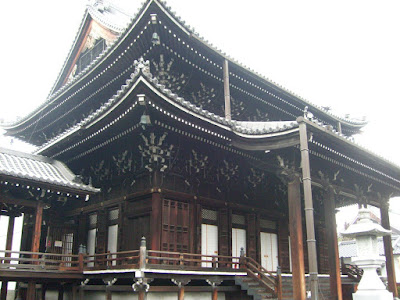
I looked around the available areas, and bumped into precisely no other tourists, because sensibly they were still tucked up in bed. The style of the temples and outbuildings would turn out to be quite typical for Kyoto, especially the
black and white square effect on the roof ends and the intricate woodcarvings that decorated the outer walls. After seeing an open shop outside one of the entrances I decided to feed my now rumbling stomach, I went down a side road where I consumed it in relative peace, sat on a post outside another temple building next door,
which looked very closed.
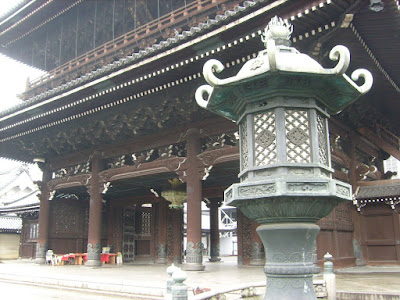
Heading over the road once more and under a promising-looking temple gate, I trotted through the
narrower streets and eventually arrived at
Higashi Hongan-ji. I initially saw the enormous structure from the back, a large, cubic building made of scaffold with white wooden cladding over it, broken up by tall, narrow windows. As I went round perimeter of the moated area, complete with
beautiful white frontage surrounded by a koi-filled moat, I was able to peer into a couple of the areas through what looked like minor entrances. Eventually I found the main gate, and going inside, found the
ugly cubic structure in front of me where a temple should be.
Thing was; this was March, so not really tourist season, so the curators of such places (I had guessed by this time) use these quiet months to perform any restoration work that is needed before the flocking crowds they get in April to June, before the sun goes a bit mental and decides to fry everyone at a heady 45 celcius. Higashi-Hongan-Ji was one place going through such an upgrade; the main temple building was cordoned off with 6ft high wooden boarding, and sat within the aforementioned scaffold structure being meticulously cleaned and restored to its former glory. It seemed to be inaccessible, but on closer inspection, the adjoining
Amida Hall was still open.

Kicking off my shoes again at the entrance, I padded through the ice-cold building, which was full of square rooms kitted out with tatami mats and bordered with sliding wooden doors, painted with spirits and deities and depictions of battles of old. Following the linear path actually took me over century old creaking wooden walkways into the main building, which was, thanks to the outer shell, pretty dark. Still, you could just make out the various carved sculptures and murals and exhibits of
rope made from the hair of the followers who built the halls, though to be honest, my main concern was that I could no longer feel my toes. It was like walking on ice.
After a while I exited, gathered up my shoes and moved on. The Shosei-en temple gardens were next on the map, but given they charged a hefty entrance fee and
it didn't look so special from the outside view, I gave it a miss. At least it was a temple - the next place in the book was Hakosen-yu, which despite being depicted as another tourist spot, turned out to be just some modern building down a back alley, as I found out after pacing up and down through several back streets, asking many slightly confused-looking residents if they had seen it.
I was feeling a bit beaten at this point, the initial enthusiasm on going through the temple capital of the country had waned significantly and so I decided that a quick subway ride to another part of Kyoto was in order; perhaps things would be different there.
Gojo was the nearest stop and took me northeast to
Imadegawa, which looked like the the best stop given its proximity to the other sights on my map.

After negotiating the exit machines and getting back to ground level through a narrow, twisty tunnel, the harsh sunlight faded to show a set of unremarkable streets. A quick detour south took me to nearby
Doshisha University, whose campus could have come straight out of the UK or America, and was filled with a mixture of
older and
newer western-style architecture and a lot of intelligent-looking students
taking in the late morning sun between lectures.
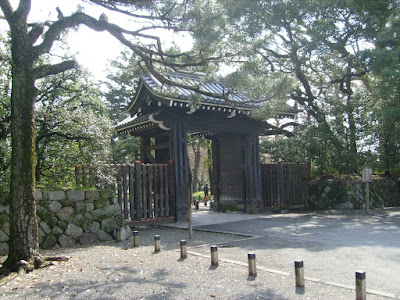
After a brief stroll, I headed back out of the gates and further south until I came to a multi-laned main road,
across from which was the corner of a very large, walled set of grounds with a thick skin of trees to block out the sound of the everyday. This was Kyoto's
Imperial Palace, a
massive rectangular area containing a patchwork of
gardens each surrounded by
wide expanses of gravel road. The scale of it all was quite dizzying. In the centre of all of this stood the inner grounds of the palace, which were themselves pretty massive. It was all designed, quite clearly to show off the power and riches of the imperial family as was, but was now lightly peppered with sightseeing tourists, or local keep-fitters or their daily run.

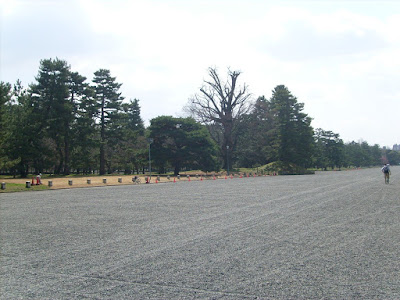
Unfortunately, the inner sanctum was all closed up, and the grounds were seemingly endless, so after a bit of walking, (and seeing the first of the
Sakura blossoms for this year) I decided it would be best to move to the next and most anticipated place on the map:
The Golden Temple, located at the north-western corner of Kyoto. This involved heading back north west, over a network of small roads through a small, cramped residential area (in which I was warned about
spooky cats). Looking at the map, it looked like about 2 miles to get there as the crow flies, so after getting an energy drink, a donut and some choccy from a nearby shop, I set off.
Along the way, there were
plenty of
smaller-scale temples and
shrines, but none of them looked particularly appealing; they were all beginning to look very alike by this point, and my confidence about my sense of direction was being put to the test.

Eventually, the overbearing buildings relaxed their grip on the streets and I was on a main road once more, each side lined with small shops selling vegetables and household stuffs, with the odd trinket shop in amongst, suggesting I was quite near
something. By now, there should have been some sign pointing to the Golden Temple, but there was nothing leaping out from the various signposts. Just at the right point, a couple from London happened to pass by. (no, really; I couldn't believe the convenience myself)
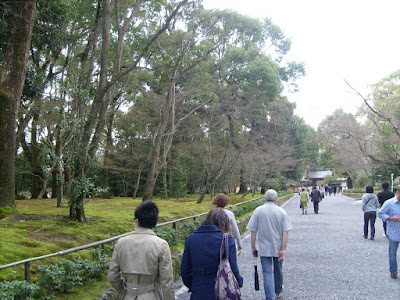
John and Joanna were also looking for the Golden Temple, but they had a better clue of where they were and were following with confidence a route layout that I'd long since given up on. I gladly let them show the way as we headed uphill and eventually ended up at the entrance to Kinkaku-ji, the famous Golden Temple. Unlike
Ise-shi the previous day, the temple is located in quite modest sized grounds, so there is only a
short stroll through a garden before the pathway opens up to reveal the main attraction.

Most people will have seen the temple in pictures, if not heard of it outright. It is one of the most iconic images of Japan, a beautiful, 700-year old Zen temple clad all in gold, floats on a wooden island in the centre of a large pond, called the
Mirror Pond, because on calm days it is perfectly flat mirroring the temple and the forests around it without imperfection. To look at the pictures, you would think it is deep in the forests outside of Kyoto, but in fact it is about a half hour on foot from the central train station.

Aside from a rather cheeky crow who decided to perch on top of the phoenix weather vane on the top of the temple, it was a perfect photo opportunity, and despite it still being outside the tourist season, the crowds had come en masse to see it, and the weather dutifully let out a few rays of proper sunshine from between the clouds. It was nearly perfect weather, though the slight breeze was spoiling the mirror lake a bit. I lost sight of John and Joanna some way in, probably with a mixture of gawping at the splendour and making faces at the Koi (who had learned all the best
places to congregate to get fed), and made my way around at a leisurely pace, exploring the understandably
less popular buildings within the
gardens,

trying to get a ding with my few available 1 yen coins by
flinging it into a pot, buying some more postcards from the obligatory
souvenir shop, and avoiding paying a few hundred yen just so I could sit in the
special area designated for people to drink green tea. I was that carried along with the crowds (and it was a one-way system), that I went back to the start and went through again, fortunately my ticket hadn't been stamped so it was probably OK.
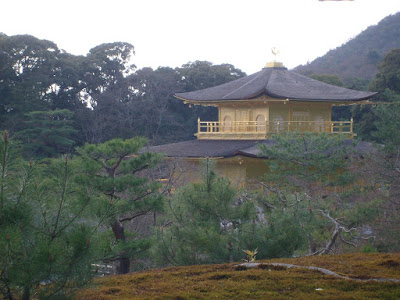
I met briefly with the saviour couple, who had chosen to have a breather at a picnic area, and we carried on a brief chat that had begun on the way to the temple, about what they had done and where they were going next, and my mixed bag of temples and sore feet. We parted ways shortly after, but not before Joanne made a suggestion about my next stop:
Nijo Castle, which they had been to and really liked. I left the temple grounds and retraced my steps to the main road where I had met the couple, then
headed downwards until my now retrieved Kyoto map told me there would be a bus stop. Kyoto buses work on a colour system, but the maps on the bus stops were still a little confusing, but again help was on hand by an elderly Japanese gentleman and a New Zealand student who was just finishing a year in Japan, who between them managed to get me on the correct bus.
It felt good to get to Nijo with something else taking the strain, and for a flat 220 yen fare (about £1.10) it was worth it. The bus dropped me off a block away from the temple, and from there I was able to
trace around the perimeter moat to get to the entrance, where even the adjacent
pathways were intricately paved and the hedges meticulously neat.

Nijo castle has seen many changes due to feud and fire during its 400 year history, and its grounds contain two single-storey palaces and no actual castle; the
Ninomaru Palace in the outer, larger main section, and then the
Honmaru Palace behind a second level of walls and moats.

The Ninomaru Palace, which is known for its intricate wood carvings on its outside, the best example being the
Kara-mon entrance, which was right in front as I went into the main area. Above the entrance is a fantastic carving of
cranes and peacocks on a lily pond. Inside, those pesky no-camera signs were in force again, although this time they were joined by an explanation board that in broken English warned that flash photography would harm the already fragile paintings inside. I tried to get some non-flash pics but they were far too dark.

The insides of the temple were covered with partially faded designs of horned beasts and wars and skirmishes, plenty of gold leaf, especially on the
ornate ceilings, and as you went through the five sections of the palace, it became gradually more luxurious, suggesting that the riff-raff at the time would be kept waiting in the first bit, whilst those with riches or respect would be invited to the inner sanctum. Exiting the palace, I walked around the
pathways through the gardens as the mid-afternoon sun shone gently down, and then after seeing all that I could, including the
koi ponds and
water gardens,
intricate rock gardens and
beautifully cared-for plants and
trees, and the
Donjon viewing platform of the central Honmaru palace, (previously a defensive turret or keep which had burned down some centuries previous, and the stone platform all that remained gave
great views of the grounds) and then left by bus for the centre of Kyoto once more.

The reason for my hasty retreat was because my future hotel bookings were catching up with me, and the day after tomorrow I would be in Hiroshima with no place as yet to stay. Despite swearing blind that I had seen a JTB near the station I could not find it second time around, and so returned to the expensive internet cafe and booked over the internet. I tried to book for the intended stops on Shikoku Island (ideally Matsuyama and Takamatsu) but I was too late on booking those, so would have to rely on finding a JTB in Hiroshima.
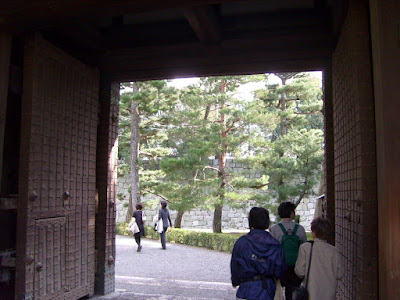
After getting a small meal, (I was not feeling so good) I went back to my hotel and got my laundry sorted out, then went back to my overheated room after chatting with a few friends on the pay-as-you-go internet in the lobby. It was only 8pm, but I was beginning to feel that I couldn't manage any more of Kyoto, so I had a long soak in the Japanese-style sit-down bath in my room (the water comes up to your neck) and then got into bed. Little did I know at the time, the next 24 hours would be the hardest of the holiday.




